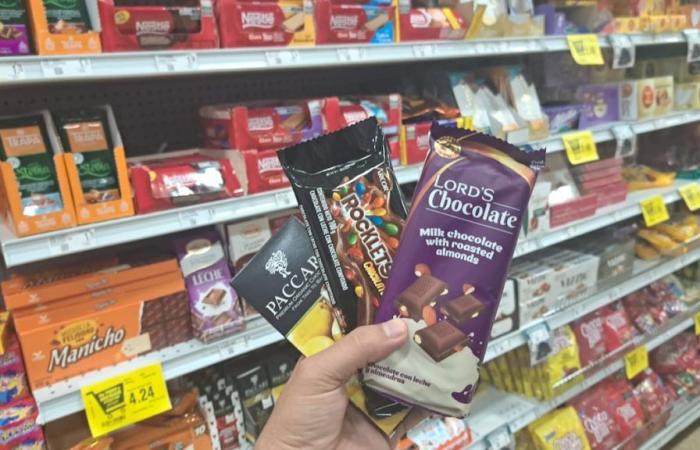
A bar of milk chocolate with almonds from an Ecuadorian brand is sold for $2.47 on the shelves of a supermarket chain in southern Guayaquil. On the same shelf, another very similar product, of the same weight and of Peruvian origin, is priced at $1.47.
There are local products that are still sold cheaper than imported ones, but more and more options from other countries are beginning to enter with greater added value and at more competitive prices.
And this is another factor that worries the national chocolate industry, added to the price of its raw material: cocoa, which has high volatility. In April it reached its highest ceiling with more than $12,000 per ton, in May it stabilized at around $7,000, last week it again exceeded $10,000 and this Friday, June 28, it closed at $7,520 on the New York Stock Exchange. according to the latest report from the specialized portal Investing.com.
High cocoa prices impact imported and domestic chocolates, which are more expensive on the shelves
‘In Ecuador, chocolate consumption is low, they prefer substitutes’
According to Iván Ontaneda, president of the board of directors of the National Association of Cocoa Exporters of Ecuador (Anecacao), there are several challenges for the national chocolate industry.
- The low per capita consumption of chocolate in Ecuador, between 300 and 800 grams, is due to the fact that the majority of the products consumed in the country are chocolate substitutes, which are mainly obtained from sugars, artificial flavours and a minimum percentage of cocoa, replacing cocoa butter totally or partially with other vegetable fats.
- The production costs that make Ecuador an expensive country to produce chocolate. “The problem is that making chocolate in Ecuador is expensive, the labor is more expensive, the ingredients are more expensive, the sugar is more expensive, the milk is more expensive, so making it in Ecuador makes the price of chocolate more expensive.” Ecuador, those are the distortions that exist,” Ontaneda laments.
- It reveals that within the recipe of a chocolate, cocoa does not represent more than 10%. “That’s why even a chocolate made in the United States that doesn’t have cocoa, but has cheaper milk and sugar, is cheaper.”
How much is the price per quintal of cocoa that the producer receives in Ecuador?
These differences that the president of Anecacao refers to are reflected in the prices with bars made with high cocoa content, up to 70% or more, for example, from a national brand that sell from $2.88 to $ 3.99 per 50 gram bar, compared to other products with lower cocoa content, imported from European countries, which sell for $5 per 300 gram bar.
It is part of the chocolate range from Germany, Belgium, Portugal, Spain and countries in the region, such as Brazil, Colombia and Peru, which is found in supermarkets.
Christian Wahli, executive president of the National Association of Food and Beverage Manufacturers (Anfab), assures that it is very likely that in the local market there will be European chocolates at lower prices than those produced locally.
Why the price difference?
The trade agreement with the European Union (EU) benefits European chocolates.
Wahli confirms what Ontaneda said, highlighting that in Europe ingredients such as milk and sugar are half the price that must be paid in Ecuador. He explains that before the trade agreement with the European Union, which came into effect in January 2017, Europe paid a 20% tariff on chocolates entering Ecuador, which has since disappeared.
He adds that some European countries such as England and Holland, among others, have the right to replace cocoa butter with other cheaper vegetable butters. “It should also be noted that production technology is much more developed in these European countries and there are very few Ecuadorian industries that reach this level of competitiveness,” acknowledges the head of Anfab.
Cocoa prices rise again, worrying exporters who must buy the August harvest
There is also an economy of scale that allows costs to be reduced for European manufacturers. Wahli highlights that some large companies are depleting stocks before the price increase (of cocoa) and there is a marketing strategy of certain companies that resist passing the bill to consumers.
He compares the situation of chocolate with that of dairy products, indicating that European cheeses – partially or totally freed from tariffs – reach the shelves of Ecuador at a lower price than cheeses produced in the country. “Ecuador is definitely an expensive country when it wants to compete in mass consumption products. The only thing left for us is to concentrate on niche, high-quality products, with specifically Andean ingredients.”
However, Francisco Jarrín, president of the Guayaquil Chamber of Industry, points to other alternatives. “In what has to do with production costs, it is important to reduce tariffs for raw materials and capital goods, alleviate fiscal pressure, improve the labor contracting regime, deepen the regulatory improvement in regulations that make productive activity more expensive.” (YO)

